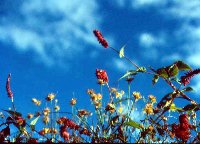
|
Rolwaling, On Your OwnClimate [ Home ] [ Getting There ] [ What to Do ] [ Climate ] [ Culture ] [ Summiters ] [ Full Rolwaling Menu ]
|
|
Rolwaling’s unique climate is shaped by a number of interacting factors. These include the latitude, the regional monsoonal system, and the local topography -- a high valley tightly cradled among snow-clad peaks, running west-to-east from the massive glaciers above Tsho Rolpa down to the convergence with a much warmer Tamba Valley. Due to the elevation, average monthly temperatures are fairly low throughout the year, with lows typically ranging from –16°C to 8°C in Beding during the evening. As elsewhere in Nepal, the low latitude (~28°N, comparable to southern Florida), however, results in surprisingly brief and moderate winters. Average monthly highs range from 3°C to 17° C. Solar radiation at high elevations is intense due to the low humidity and low proportion of oxygen in the atmosphere; this causes a sharp contrast between temperatures in the sunshine and in the shade. Afternoon fog or even a passing cloud can make you regret hiking in t-shirt and shorts. The low latitudes also result in a fairly even division of daytime and nightime: it is light for at least 11 hours throught the year. During the winter, the valley experiences small amounts of dry snow. Summers are rainy, but the east-west orientation of the valley, and the high mountains to the east and along the southern valley wall disrupt the monsoonal weather pattern: technically, this is a "dry inner valley." However, despite the relatively low rainfall, Rolwaling is by no means arid. Afternoon fogs roll in from the Tamba Kosi in during most of the year, most markedly before and after the rainy season, not so dramatically during the late fall and winter. During the summer, skies are typically overcast all day. From November until the end of April, the days are typically clear, with only occasional storm systems moving in. The dynamic character of Rolwaling's climate creates a very "patchy" environment, with highly compressed ecotones and sharp differentiations according to exposure to the sun. The differences in vegetation between the north-facing and south-facing slopes are quite remarkable. |